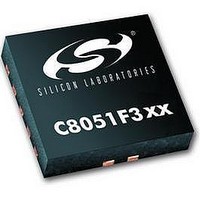C8051F302 Silicon Laboratories Inc, C8051F302 Datasheet - Page 75

C8051F302
Manufacturer Part Number
C8051F302
Description
IC 8051 MCU 8K FLASH 11MLP
Manufacturer
Silicon Laboratories Inc
Series
C8051F30xr
Specifications of C8051F302
Core Processor
8051
Core Size
8-Bit
Speed
25MHz
Connectivity
SMBus (2-Wire/I²C), UART/USART
Peripherals
POR, PWM, Temp Sensor, WDT
Number Of I /o
8
Program Memory Size
8KB (8K x 8)
Program Memory Type
FLASH
Ram Size
256 x 8
Voltage - Supply (vcc/vdd)
2.7 V ~ 3.6 V
Data Converters
A/D 8x8b
Oscillator Type
External
Operating Temperature
-40°C ~ 85°C
Package / Case
11-VQFN
Data Bus Width
8 bit
Data Ram Size
256 B
Interface Type
I2C, SMBus, UART
Maximum Clock Frequency
25 MHz
Number Of Programmable I/os
8
Number Of Timers
16 bit
Operating Supply Voltage
2.7 V to 3.6 V
Maximum Operating Temperature
+ 85 C
Mounting Style
SMD/SMT
Minimum Operating Temperature
- 40 C
On-chip Adc
8 bit
Lead Free Status / RoHS Status
Contains lead / RoHS non-compliant
Eeprom Size
-
Lead Free Status / Rohs Status
No
Available stocks
Company
Part Number
Manufacturer
Quantity
Price
Company:
Part Number:
C8051F302-GMR
Manufacturer:
SiliconL
Quantity:
3 000
Company:
Part Number:
C8051F302-GMR
Manufacturer:
SILICON
Quantity:
5 000
Part Number:
C8051F302-GMR
Manufacturer:
SILICONLABS/èٹ¯ç§‘
Quantity:
20 000
C8051F300/1/2/3/4/5
8.4.
Power Management Modes
The CIP-51 core has two software programmable power management modes: Idle and Stop. Idle mode halts the CPU
while leaving the peripherals and clocks active. In Stop mode, the CPU is halted, all interrupts and timers (except the
Missing Clock Detector) are inactive, and the system clock is stopped (analog peripherals remain in their selected
states). Since clocks are running in Idle mode, power consumption is dependent upon the system clock frequency and
the number of peripherals left in active mode before entering Idle. Stop mode consumes the least power. Figure 1.15
describes the Power Control Register (PCON) used to control the CIP-51's power management modes.
Although the CIP-51 has Idle and Stop modes built in (as with any standard 8051 architecture), power management
of the entire MCU is better accomplished by enabling/disabling individual peripherals as needed. Each analog periph-
eral can be disabled when not in use and placed in low power mode. Digital peripherals, such as timers or serial
buses, draw little power when they are not in use. Turning off the oscillators lowers power consuption considerably;
however a reset is required to restart the MCU.
8.4.1. Idle Mode
Setting the Idle Mode Select bit (PCON.0) causes the CIP-51 to halt the CPU and enter Idle mode as soon as the
instruction that sets the bit completes execution. All internal registers and memory maintain their original data. All
analog and digital peripherals can remain active during Idle mode.
Idle mode is terminated when an enabled interrupt is asserted or a reset occurs. The assertion of an enabled interrupt
will cause the Idle Mode Selection bit (PCON.0) to be cleared and the CPU to resume operation. The pending inter-
rupt will be serviced and the next instruction to be executed after the return from interrupt (RETI) will be the instruc-
tion immediately following the one that set the Idle Mode Select bit. If Idle mode is terminated by an internal or
external reset, the CIP-51 performs a normal reset sequence and begins program execution at address 0x0000.
If enabled, the Watchdog Timer (WDT) will eventually cause an internal watchdog reset and thereby terminate the
Idle mode. This feature protects the system from an unintended permanent shutdown in the event of an inadvertent
write to the PCON register. If this behavior is not desired, the WDT may be disabled by software prior to entering the
Idle mode if the WDT was initially configured to allow this operation. This provides the opportunity for additional
power savings, allowing the system to remain in the Idle mode indefinitely, waiting for an external stimulus to wake
up the system. Refer to
Section “16.3. Watchdog Timer Mode” on page 156
for more information on the use and
configuration of the WDT.
8.4.2. Stop Mode
Setting the Stop Mode Select bit (PCON.1) causes the CIP-51 to enter Stop mode as soon as the instruction that sets
the bit completes execution. In Stop mode the internal oscillator, CPU, and all digital peripherals are stopped; the
state of the external oscillator circuit is not affected. Each analog peripheral (including the external oscillator circuit)
may be shut down individually prior to entering Stop Mode. Stop mode can only be terminated by an internal or
external reset. On reset, the CIP-51 performs the normal reset sequence and begins program execution at address
0x0000.
If enabled, the Missing Clock Detector will cause an internal reset and thereby terminate the Stop mode. The Missing
Clock Detector should be disabled if the CPU is to be put to in STOP mode for longer than the MCD timeout of
100 µsec.
Rev. 2.3
75











